| “ | Well, first, I didn't kill Dr. King. | ” |
— Ray
| ||
James Earl Ray was the assassin of American Baptist minister and civil rights activist, Dr. Martin Luther King, Jr.
Background[]
Ray was born in on March 10, 1928 in a poor Irish-American family of Alton, Illinois, and was raised a Catholic. Shortly before his seventh birthday, in 1935, his father passed a bad check and the Rays fled to Ewing, Missouri, where they changed their name to Raynes to avoid detection. Ray dropped out of school when he was fifteen years old. Later, he volunteered for the U.S. Army near the end of World War II and served in Germany.
Ray was convicted for the first time, for burglary, in 1949. In 1952 he was sentenced to two years for the armed robbery of a taxi driver in Illinois, and in 1955, to four more years for stealing money orders in Missouri and modifying them to travel to Florida. In 1959 he was arrested again for armed robbery in St. Louis and he was sentenced to twenty years for repeated offenses. However, he escaped in 1967 by hiding in a bread truck leaving the prison's bakery. He moved through St. Louis, Chicago, Toronto, Montreal, and Birmingham, Alabama, where he acquired a car and driver's license and drove to Mexico. He resided briefly in Acapulco and Puerto Vallarta, where he tried to start a career as a pornographic director, but he left soon for Los Angeles. How Ray financed his lifestyle after escaping prison remains a long-time mystery; it is possible that he was one of two masked gunmen who robbed a bank in Ray's hometown of Alton in the summer of 1967, making off with some $30,000. This is consistent with Ray using small denomination bills to purchase cars and weapons.
Ray was strongly prejudiced against black people. He was a firm supporter of the pro-segregationist, third-party presidential campaign of Alabama Governor George Wallace, and he spent much of his time in late 1967 and early 1968 volunteering at the Wallace campaign headquarters in North Hollywood. However, it was deemed implausible by many, including his brother Jerry, that Ray acted for any reasons other than money.
Murder of King, Incarceration, and Death[]
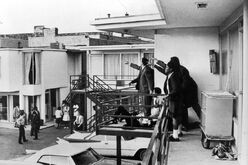
King's companions rise their fists in the direction the shot came from while King lies mortally wounded on the ground.
Ray's apparent plan hinged on three premises:
- Avoiding capture and leaving the country in the immediate aftermath of the assassination, as he had already done when he escaped from Missouri State Penitentiary in 1967;
- Taking refuge in Rhodesia (modern day Zimbabwe), a white-dominated apartheid state that had proclaimed unilateral independence from the United Kingdom in 1965 and had no extradition treaty with the U.S.; and
- Waiting for Wallace to be elected president, which Ray took for granted, then return to the U.S. after receiving a presidential pardon from him.
On March 5, 1968, Ray underwent a rhinoplasty in Los Angeles. Thirteen days later, he drove to Atlanta, where he bought a map of the city and circled the location of King's house and church. Two further weeks later, he drove to Birmingham, Alabama, where he bought a pump-action rifle, cartridges, and a telescopic sight under different aliases. When asked, he said it was for a hunting trip. He returned to Atlanta and stayed there until he read in the Atlanta Constitution that King was traveling to Memphis, Tennessee on April 1. The next day, he left for Memphis and rented a room in a boarding house across the street from King's room in the Lorraine Motel. At 6:01 PM, April 4, he shot King on the head once, while he was standing on the motel's balcony. Witnesses saw Ray running away from the scene, and his fingerprints were found in the rifle and a pair of binoculars which were left in a package nearby.
Ray drove back to Atlanta for eleven hours straight, picked his belongings, and left for Canada. On the way north, he heard on the radio that Police was looking for a man of his likeness and driving his vehicle's model, a white 1966 Ford Mustang. He abandoned the vehicle immediately and crossed the border by train two days after the murder. After another day, Ray arrived in Toronto and he hid there for a month, during which he acquired a Canadian birth certificate for "Ramon Sneyd". He used the certificate to apply for a passport, and on May 7 he flew to London and right after to Lisbon, Portugal, which was one of the few cities in the world with a Rhodesian embassy. However, a clerical mistake resulting in "Sneya" being written in the passport instead of Sneyd prevented him from sailing to Africa. Although Ray managed to get a corrected passport from the local Canadian embassy, his time run out and he was forced to fly back to London after ten days in the Iberian country.
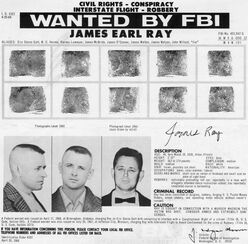
Ray's FBI wanted poster.
In London, Ray called Ian Colvin, a journalist at The Telegraph, and asked him for contacts that could allow him to become a mercenary in Africa. Colvin suggested an unnamed man in Brussels who had dealings in Congo. By this point, Ray had run out of cash and the FBI had learned that he was using the alias Ramon Sneyd from the Canadians. He attempted to rob a small jewelry store on May 27, but the elderly owners attacked and attempted to disarm him, much to his surprise; when they pressed the alarm button, he fled empty-handed. On June 4, Ray robbed a Trustee Savings Bank but he only made out with about £100. He bought a ticket to Brussels and was ready to embark at Heathrow on June 8, when an immigration officer caught a glimpse of Ray's old passport and inquired him about it. Ray relied that the passport was issued incorrectly and that he had replaced it, but a Special Branch officer was suspicious and took him into custody. After determining Ray's real identity, Scotland Yard decided not to pursue charges for the robberies and he was returned to the U.S. under FBI guard, on July 18.
On March 10, 1969 Ray confessed to the murder and entered a guilty plea on the advice of his first attorney, Percy Foreman, who especialized in helping clients avoid the death penalty. Ray was then sentenced to 99 years in prison. Three days later, Ray fired Foreman, recanted his confession and claimed he was the victim of a conspiracy. He would unsuccessfully request his guilty plea to be withdrawn and to be granted a trial for the rest of his life. On June 10, 1977 he escaped from prison again, along with six other convicts, but they were all recaptured after three days. Another year was added then to Ray's sentence, bringing it to 100 years. He died in prison on April 23, 1998, as a result of complications from Hepatitis C that he contracted from a contaminated blood transfusion while he was incarcerated.
Motive[]
Ray's exact motive for murdering King isn't clear since he denied his guilt later, claiming he was a fall guy in a plot he had been involved in by "Raoul", an enigmatic (and non-existent) Latino man who, according to Ray, represented the main forces behind the assassination. Both notoriety and racism have been suggested, although it was deemed implausible by many, including his brothers Jerry and John, that Ray acted for any reasons other than money, as suggested by his record for property-related crimes. According to the House Select Committee on Assassinations' conclusions, Ray acted in conjunction with one or both of his brothers on the premises that they would have received a large payment for the murder. This was suggested by the testimony of Russell G. Byers, a St. Louis small-time criminal who claimed segregationist leader and Wallace's campaign supporter John Sutherland, along with an associate of the latter named John Kauffmann, attempted to hire him to kill Dr. King or arrange the killing in early 1967. Kauffmann was a frequent patron at Grapevine Tavern, which was managed by Ray's brother, John, and sister, Carol. It is possible, although never ascertained, that the Ray brothers heard about the contract hit and decided to act.
Byers had previously told the same story to his former lawyers, Lawrence Weenick and Murray Randall, as well as to a criminal associate who was also an FBI informant. For reasons unknown, the Bureau failed to investigate the information for five years, until it was finally reported to the HSCA in 1978. It is worth noting that Randall cast doubts on Byers' recollection, citing inconsistencies in the version he had previously provided to him, as well as his belief that Byers made up the story to find out whether his criminal associate was an FBI informant or not (and, in fact, he was). Nonetheless, the HSCA chose to believe Byers, whose account was apparently confirmed by a fellow inmate of Ray. This version of the events would be consistent with the Ray brothers' racist beliefs: they may well have been convinced that no Southern jury would have convicted the assassin of Martin Luther King for murder (the Ku Klux Klan members responsible for the so-called "Mississippi Burning Murders" were only convicted of conspiracy to violate civil rights), so the crime was worth the risks if it guaranteed profit. It would also be consistent with Ray making up the "Raoul" persona (whose movements and contacts with Ray strangely mirrored those of his brothers) to protect his family, to whom he was emotionally attached, while at the same time suggesting there was "something more" out there to be investigated.
Conspiracy Theories[]
Ray's claims[]
After Foreman, Ray hired Jack Kershaw, a noted segregationist, and Southern secessionist, and claimed that he was the fall guy in a conspiracy involving several people. According to Ray, he was brought into the plot by a man named Raul that he met in Montreal in 1967. He admitted being in Memphis at the time of the murder and witnessing it, but denied being the shooter, and claimed that he purposely left his prints on the gun because he wanted to be famous. This was seemingly supported by witnesses who claimed that the shot was fired behind thick shrubbery at ground level and not from the window on Ray's room. At one point, Ray even identified the shooter as his elder brother John Larry Ray, who had been his accomplice in some robberies during the 1950s.
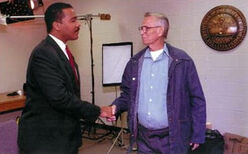
Ray meeting Dexter King in 1997.
In May 1977, Kershaw convinced the House Select Committee on Assassinations to perform ballistics tests that he claimed would prove Ray didn't shoot King, but the results were inconclusive. A wider investigation also failed to find evidence of a conspiracy while Ray was at large. Nevertheless, when Ray escaped from prison a month later, Kershaw (who continued to represent him) said that the escape was evidence of powerful figures helping Ray. After his recapture, Kershaw convinced Ray to give an interview to Playboy and to take a polygraph test whose results would be published alongside with it. Rather than exhonerating him, the magazine claimed that the polygraph results confirmed Ray as the sole murderer beyond doubt. When Ray learned that Playboy had paid Kershaw $11,000 for the interview, he fired him and replaced him with Mark Lane, a noted JFK assassination conspiracy theorist. Another conspiracy theorist, William Francis Pepper, represented Ray during a mock trial in 1993 in which Ray was found innocent.
In 1997, King's son Dexter met Ray and asked him, "for the record, um, did you kill my father?", to which Ray replied, "No. No, I didn't." From then on, King's family stated publicly that they did not believe Ray was the real murderer and supported his efforts to get a trial until his death.
Loyd Jowers[]
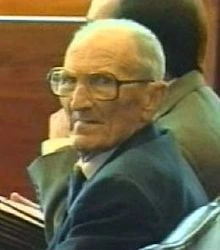
Loyd Jowers.
Loyd Jowers (1926 - 2000) was the owner of Jim's Grill, a restaurant near the Lorraine Motel. After Ray's mock trial, Jowers claimed on TV that he was paid $100,000 by Frank Liberto, a deceased tradesman with ties to the Mafia, in exchange for hiring a hitman to kill King. He also claimed the unnamed hitman was not Ray. In 1998, the Kings sued Jowers "and other unknown co-conspirators" for the wrongful death of King. The ensuing trial was extremely unusual: it relied almost entirely on second or third hand witness accounts, other than Jowers; two former employees of Jowers who had supported his version earlier recanted, with one admitting that Jowers fabricated the story with the aim of selling its rights for a book or movie for $300,000; and Jowers himself agreed with the Kings (represented by Ray's last attorney, Pepper) in that he was part of a conspiracy involving not just the organized crime of Memphis and New Orleans but also the Memphis Police Department, the FBI, CIA and U.S. Military. None of these agencies were accused in the lawsuit and thus could not take part in the proceedings to defend themselves.
On December 8, 1999, Jowers was found guilty of being part of a conspiracy to kill King, along with "others, including government agencies". The shooter was not named, but Dexter King claimed that Jowers had earlier accused Lt. Earl Clark, a Memphis Police Department Officer who died in 1987. Jowers himself died from a heart attack five months after the verdict, on May 20, 2000. An investigation of the Department of Justice concurrent with the trial published its own report on June 9, rejecting all allegations of a conspiracy to kill King, although it also admitted that there were too few leads remaining 30 years after the murder. The DOJ highlighted that Jowers had been extremely inconsistent about the identity of the shooter, blaming at different times an African American man firing from South Main Street, Raul, a white MPD Lieutenant, and someone he didn't recognize.
Other claims[]
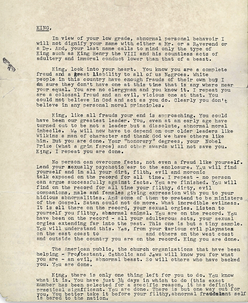
The FBI-King Suicide Letter.
People who believe in the conspiracy point that King was monitored by the FBI's COINTELPRO since 1963, on direct orders from J. Edgar Hoover, who considered him a subversive and a communist; and that the Bureau had mailed him an anonymous letter in 1964, blackmailing and inviting him to commit suicide. It has also been claimed that officers tasked with security in the area near the Lorraine or that could harbor sympathy for King were inexplicably removed from their posts on the day of the murder. Reverend James Lawson, one of King's friends, believes that King was murdered on April 4, 1968, because it was the anniversary of King's anti-war speech "Beyond Vietnam", and that the assassination was a last-ditch attempt to deflate King's impending Poor People's March on Washington. Another church minister, Ronald Denton Wilson, claimed in 2002 that King's murder was masterminded by his father, Henry Clay Wilson, because he believed that King was a communist. Wilson had previously stated that his father was a member of the Ku Klux Klan, but he denied that the murder was racially motivated. However, he offered no evidence of any claim.
Modus Operandi[]
Ray was an avid reader who learned much of the information needed for his attacks from newspapers, including King's favorite room at the Lorraine Motel and his schedule. On the day of the assassination, he fired a single .30-06 bullet through the boarding house's bathroom window with a Remington Model 760 rifle. King, who was standing on the Motel's balcony near his room, was hit on his right cheek; the bullet caused fatal damage as it deviated downward, breaking King's jaw and several vertebrae and blood vessels before lodging into his shoulder. After the attack, Ray wrapped the rifle and binoculars in a blanket and dumped them while he run away from the house.
Known Victims[]
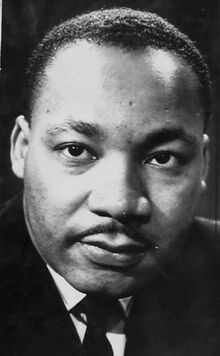
Martin Luther King.
- 1949, unspecified location in Missouri: A victimless burglary
- 1952, unspecified location in Illinois: Unnamed taxi driver (robbed at gunpoint)
- 1955, unspecified location in Missouri: A victimless theft and forgery
- 1959, St. Louis, Missouri: A Kroger store (robbed at gunpoint)
- Summer 1967, Alton, Illinois: The Bank of Alton (possibly; robbed at gunpoint)
- 1968:
- April 4, Memphis, Tennessee: Dr. Martin Luther King, Jr., 39 (fatally shot with a rifle)
- May 27, London, U.K.: Maurice and Billie Isaacs (attempted to rob at gunpoint)
- June 4, London, U.K.: Trustee Savings Bank (robbed at gunpoint)
On Criminal Minds[]
- Season One
- "L.D.S.K." - Ray's mugshot appeared alongside the mugshots and photos of other infamous assassins.
Sources[]
- Wikipedia:
- Officers suspect Illinois robbery bankrolled Ray. CNN news piece by James Polk (2008)
- Canadian connection in the Martin Luther King assassination. CBC news piece by John Nicol (2008)
- When Martin Luther King Jr's assassin fled to London. BBC news piece by Vincent Dowd (2016)
- James W. Clarke. American Assassins: The Darker Side of Politics. Princeton University Press. 1982. ISBN: 978-0-608-09575-2
- The Plot to Kill King - stlmag.com
- Findings on Martin Luther King, Jr. Assassination | National Archives
